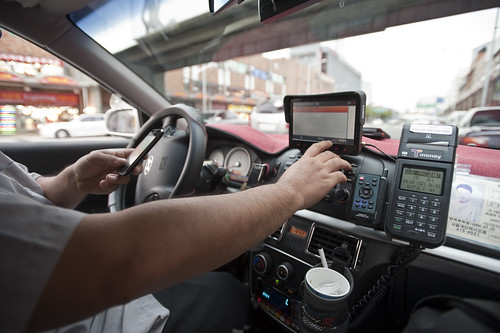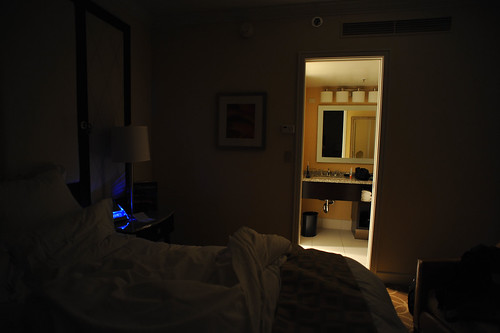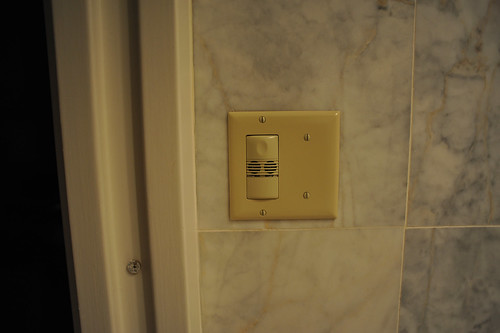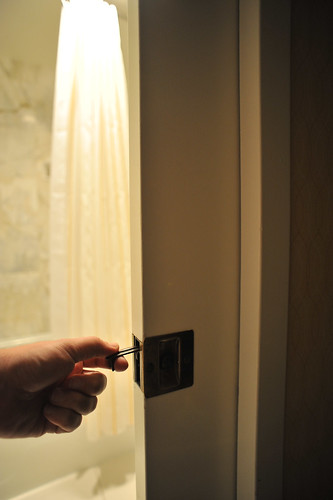
Dashing off into the ubiquitously connected crisis of effects. Montreal, with two chums in the back seat educating me on the consequences of a world of ubiquity — one in which everyone is connected.
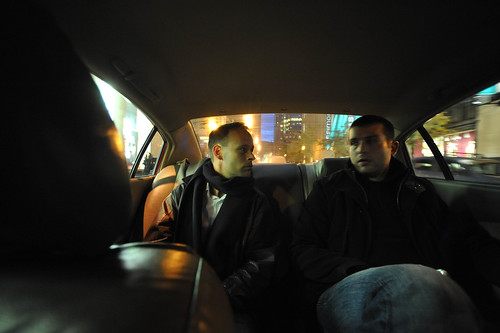
Aaron and Raph poke around the topic — consequences of everyone connected with Aaron attempting to emit laser beam communications networks from his eyeballs.
From the vantage point of the “credit crisis” (really a crisis of trust, but it’ll take the perspective of historical reconsideration in the inevitable Ken Burns documentary 10 years hence to deliver that with some more authority than my just writing it) we meet a couple of near future design fictions. Two excerpts. First, read this one, which is likely familiar to you, if you’re one of my 4 regular readers.
The door refused to open. It said, “Five cents, please.”
He searched his pockets. No more coins; nothing. “I’ll pay you tomorrow,” he told the door. Again he tried the knob. Again it remained locked tight. “What I pay you, ” he informed it, ‘is in the nature of a gratuity; I don’t have to pay you.”
“I think otherwise,” the door said. “Look in the purchase contract you signed when you bought this conapt.”
In his desk drawer he found the contract; since signing it he had found it necessary to refer to the document many times. Sure enough; payment to his door for opening and shutting constituted a mandatory fee. Not a tip.
“You discover I’m right,” the door said. It sounded smug.
From the drawer beside the sink Joe Chip got a stainless steel knife; with it he began systematically to unscrew the bolt assembly of his apt’s money-gulping door.
“I’ll sue you,” the door said as the first screw fell out.
Joe Chip said, “I’ve never been sued by a door. But I guess I can live through it.”
This from Philip K. Dick’s hysterically prescient Ubik It’s like a near future design-gone-absurd style guide for the Ubicomp wonks. Read it, immediately, if you have not already.
It’s like a near future design-gone-absurd style guide for the Ubicomp wonks. Read it, immediately, if you have not already.
Okay. Now, read this one, from a little known writer called Jonathan Welsh.
Jamie De Lisle’s Buick had been warning her for days, first with a flashing yellow light, then a flashing red light. But the 31-year-old mother of two from Collinsville, Ill., was too busy to heed the distress signals. It was only when Mrs. De Lisle began hearing an incessant beeping that she took notice: If she didn’t make her car payment that day, the vehicle wouldn’t start the next day.
The repo man has found a new hiding place — inside your car. Increasingly, used-car dealers are installing remote disabling devices that keep the cars from starting if the buyer gets too far behind on payments.
These so-called disablers, palm-sized devices that are placed under dashboards and wired into ignitions, once were limited to what industry insiders call the “buy here — pay here” segment: the kinds of small used-car lots that line state highways, strung with lights and multicolored pennants. But as the economic downturn deepens, larger, more mainstream dealerships are using the devices as a condition of financing.
That’s from a story by a fellow called Jonathan Welsh titled Meet the Disabler found in a collection of short stories also known as news articles in the fascinating Wall Street Journal.
Why do I blog this? An excellent instance of correlate design fictions — things that have anticipated and sketch out the on-the-ground, everyday, quotidian experiences of possible near futures through science fiction. And, another reason to possibly read some science fiction as design sketches of these possible futures. In the first instance the P.K. Dick design scenario of a ubiquitously networked “smart” door that is able to express itself to the door’s leasee.
This sounds ridiculous, of course. But the backdrop, if we extend the failure scenario, is, say, the Simpson Door Company finding its course of resonance with people’s expectations about what previously “dumb” things become. They decide to explore networking their doors for, say, home security that is embedded within the objects proper (doors, windows, door knobs, etc.) rather than separate devices put in door jambs and window sashes. So, Simpson Door Company makes smart iSecure line of doors and windows with embedded smart computation and voice xml processors so you can talk to your doors — and they can talk back. They’re all hooked up through a nice, comfy-sounding creative commons protected open source API, with REST-ful networking so you don’t have to articulate the door to get it to change its color. There’s a built-in Asterisk telephony server so your phone calls follow you as you move around the house, with the doors and windows acting as large surface sound transducers. Your house, is a speaker-microphone. Then, there’s the rock-bottom edition for more dicey installations, like in shitheel day rental apts because the economy has really tanked and lots of people work day-to-day jobs that come with bunkhouse housing paid for with a bit of government stimulus to keep 1/3 of the population from being officially, certifiably, miserably homeless. Nothing stops the taskmasters from installing pay-to-egress and pay-to-ingress Simpson Door’s. So..they do.
The lines between the science of fiction and fact are like a gradient. Speculation is not forecasting, it’s making weak signals legible as possible near futures.
What is intriguing here is that the “perfect” operational scenarios hardly consider the frankly more likely scenarios that are quite a bit grittier than what gets “pitched” as the beautiful, perfect world. But, there’s a rut that is difficult to get out of, which is that people won’t buy into things that have these gritty potentialities to them, if the gritty potentialities are used as the design baseline. I find the bumpy edition of design scenarios far more compelling, perhaps because of this generally critical, sideways glance I take on these things. I want nothing of Pink Ponies and this sort of kempt future world of perfectly manicured lawns and delicate flower beds behind walled and gated borders. Terribly boring. On the other hand, pointing out the failed scenarios is also useful for talking through larger contexts such as — what experiences and circumstances yield things like The Disabler and the Door That Sues. It’s not the technical artifact that is at the heart of things. Rather the technical artifact — the ubicomp door and car — provide a way to tell stories about larger social systems and the consequences of, in this case, this financial/credit/honesty/trust crisis, which is more significant than the individual instrumentalities like these positively intractable, illegible financial instruments which were instruments of deception more than any sort of legitimate risk mitigation algorithm.
Continue reading Meet The Disabler: Ubicomp Futures Now

